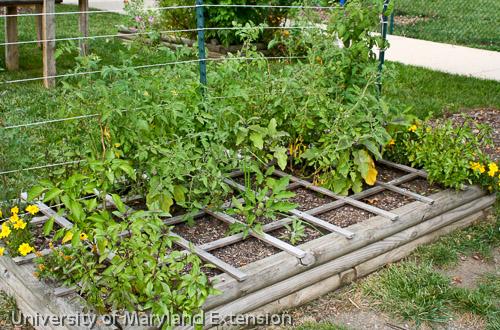What are some ways to preserve wood that will be used for a raised bed vegetable garden?
There are several options:
- Paint the wood with exterior latex paint to minimize soil contact with treated wood (Source: Oregon State Extension)
- Treat the wood with a semi-transparent oil-based stain (Source: USDA Forest Products Lab)
- Apply a heavy plastic liner between the treated wood frame and your garden soil, allowing for soil drainage (Source: Iowa State University, Mass. Dept. of Environmental Protection)
- Build your raised bed with a decay-resistant type of wood, such as cedar, black cherry, oak (bur, chestnut, post, white), black locust, Osage orange, or redwood. (Source: USDA Forest Products Lab)
- Use a non-wood material such as stones, concrete blocks, bricks, or synthetic lumber.
Should I be concerned about arsenic or other chemicals in pressure-treated wood used in raised beds?
- Micronized Copper Azole (MCA) is currently the most widely available type of wood preservative for residential use. It does not contain arsenic, but it does contain copper. It is considered to be low in toxicity. For information on the health risks associated with MCA-treated wood, refer to the National Pesticide Information Center Wood Preservatives page.
- An older type of wood preservative called Chromated Copper Arsenate (CCA) contained arsenic, copper, and chromium. CCA-treated wood is no longer available for residential use as of 2004.
- Avoid using older types of wood treatments such as CCA, creosote, and Penta-treated lumber.
- Research from Oregon State University showed that pressure-treated lumber does increase soil copper concentrations by a minor amount, but only within 1 inch of the raised-bed edge. Their study found no increase in copper concentration in the plants that were grown in raised beds made with pressure-treated lumber.
- If you have concerns about using MCA-treated wood for raised beds, paint or stain the wood, use a heavy plastic liner between the wood and your soil, or use a non-wood building material (e.g., stones, bricks). There are Additional Resources below.
Is it safe to use cement blocks to build a raised garden to grow vegetables?
- Cement block, cinder block, and concrete block, all are made with cement and fine aggregates such as sand or small stones.
- Fly ash is also often included. Fly ash is a byproduct of burning coal and so contains heavy metals and other hazardous waste.
- Labels do not give specific information on exactly what aggregate is used in the manufacture of the block. There is also little research data on this topic.
- Ultimately, this becomes a personal choice based on your comfort level. If you plan to use blocks as a raised bed material -- and many people do – and you are concerned about potential risks, you could seal the blocks with polymer paint. Or you can choose to use another material.
